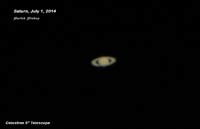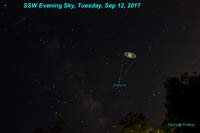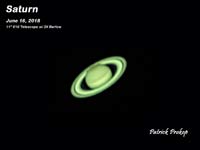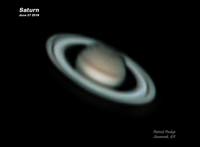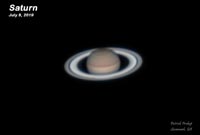
The Planet Saturn ... The 6th Planet from the Sun

The Planet Saturn
I captured this planet uing the 11" Celestron with an Explore Scientific 3X Barlow extender in my backyard on the night of July 2, 2018 (1:00 am, July 3). On an atmospheric 'seeing' scale where 0 is total cloud cover and a 10 is totally clear with low humidity and no moon glow, the sky that night was a 7. At that time, Saturn was about 888 million miles away, as compared to about 841,952,750 million miles in early Jul, 6 days before opposition, when it will be 841,346,750 away. It takes 29.457 years for Saturn to orbit the sun.
I used the software; SharpCap Pro which has a ROI (Region of Interest) function to capture the planet. Instead of taking pictures with a dimension of 4128 x 2808 px, I am able to set a capture area around the planet, and in this case, 640 x 480 pixels (there are several options for sizing the capture box). This greatly reduces the avi file size by 97% allowing for much more frames for better resolution and faster stacking times.
Techy Stuff:
Telescope: 11" Celestron Edge HD with the Explore Scientific 3x 4 Element Barlow Focal Extender yielding a focus ratio0 of f/30
Mount: CGX ii
Camera: Altair Hypercam 294C Pro tec (Color)
Capture software: SharpCap Pro 3.1
Guiding: PHD 2
Filter: City Light Pollution Suppresion
Number of Frames in .avi file: 5,000
Stacking Program: AutoStakkert! 2.6.8
Used best 2,500 of the aligned 5,000 frames for stacking
Post Processed in Photoshop CC
Seeing Conditions: 7 (0-10, where 0 is total cloud cover)
Bortle Light-Pollution zone: 6-7 (can barely see the Milkyway)
Temperature: 82°F, Dew Point 74°
Location: Backyard, Savannah GA
Some other images I took of Saturn. In the earlier years, the telescope was the Celestron 6" unguided telescope and the camera was the canon T2i, all just a single shot with no stacking. As time goes by, my equipment, software, and technique improved resulting in better and better pictures.
Return to Pat Prokop's Heavenly Backyard Astronomy Page

